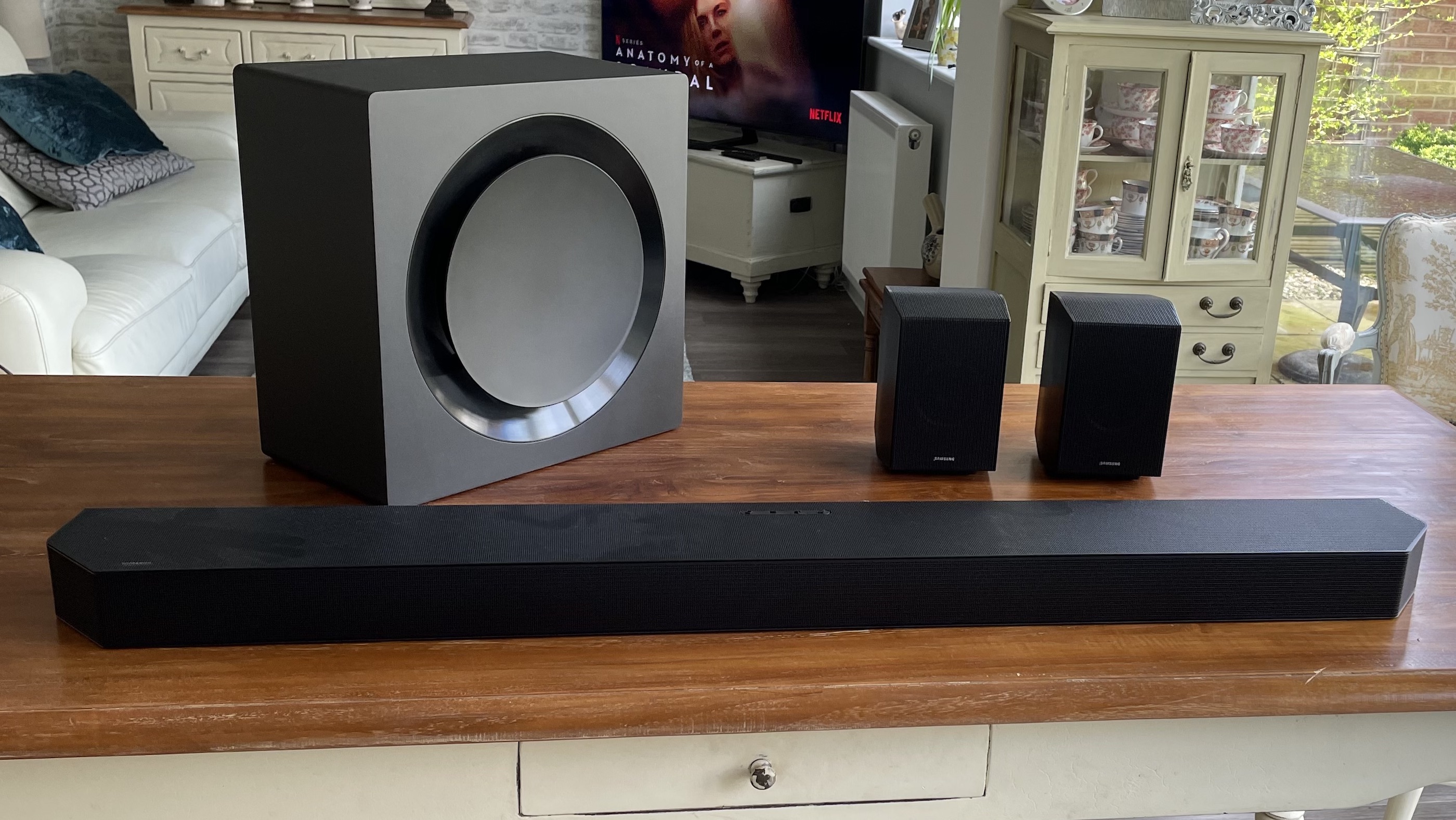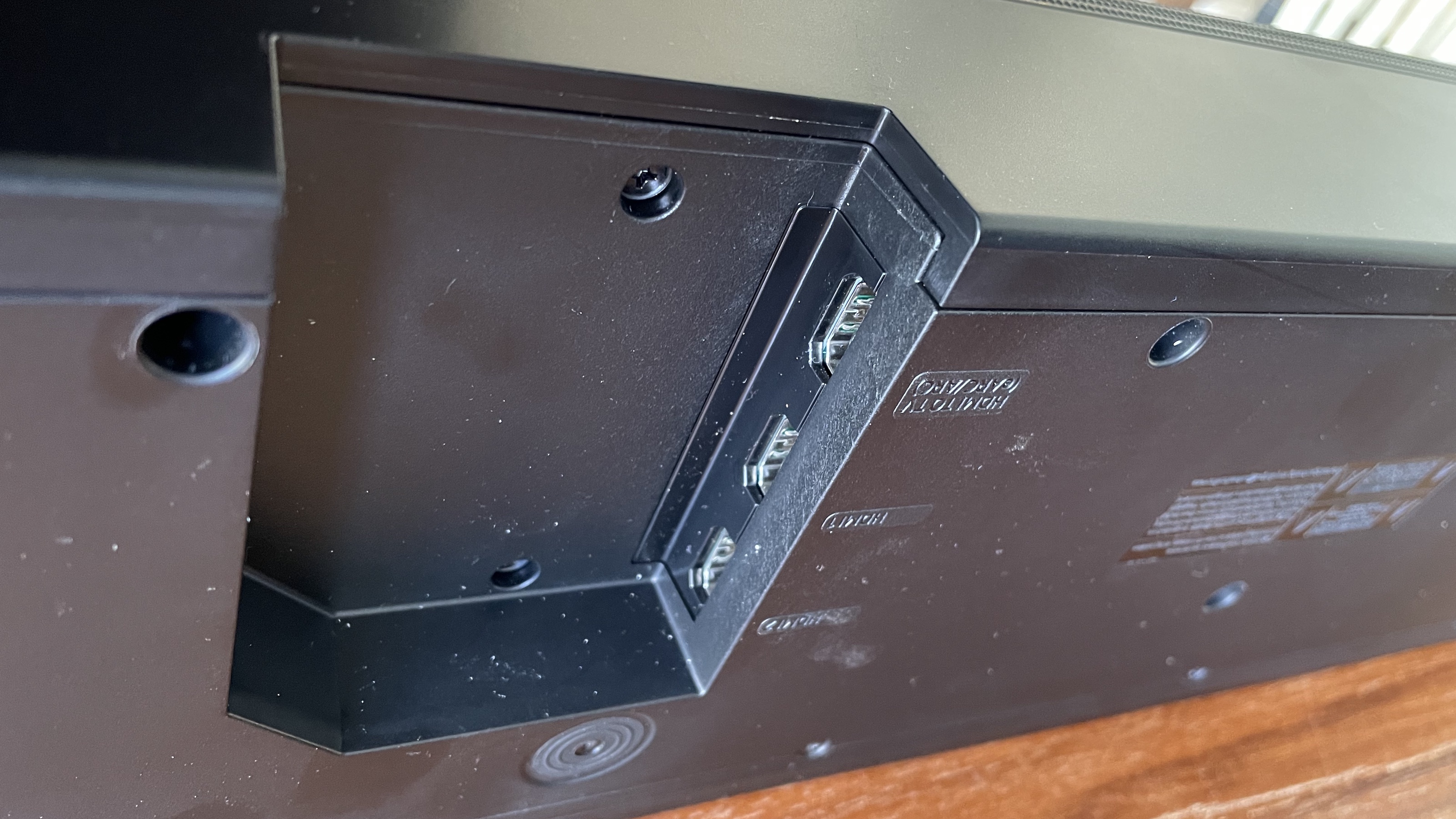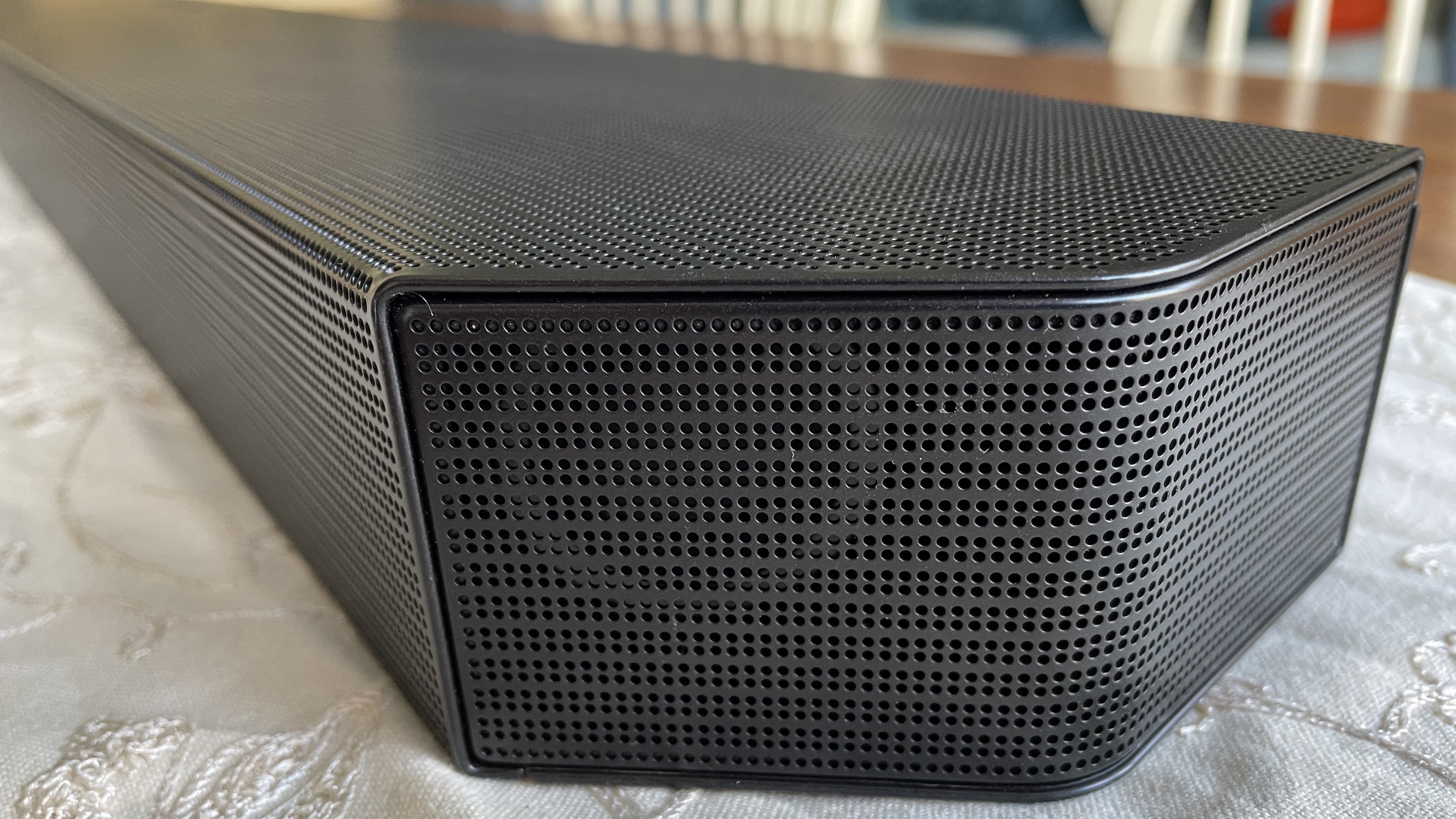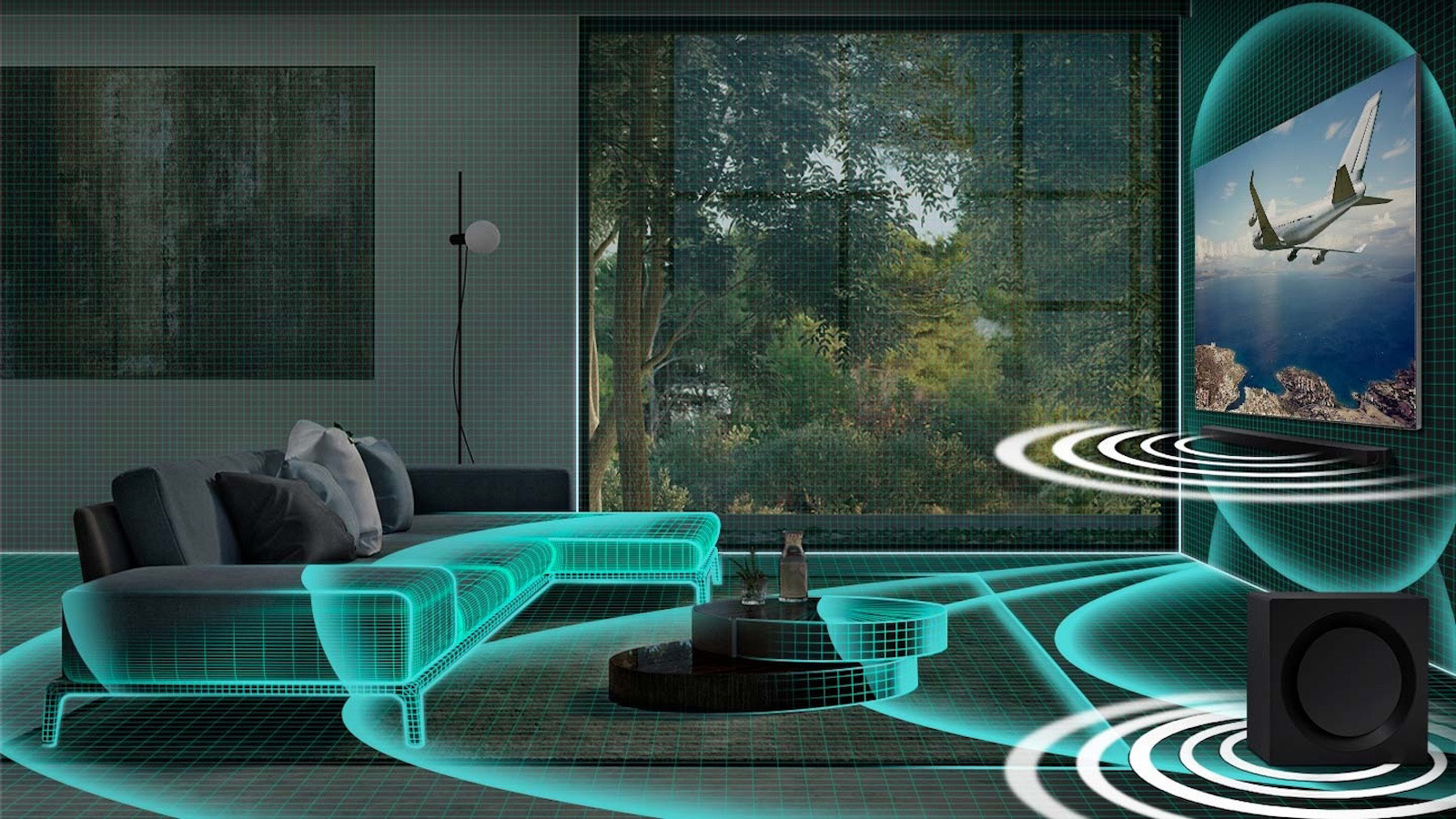Samsung HW-Q990B review: sensational surround sound
Samsung's premier soundbar delivers a 11.1.4 surround experience, making for total immersion. Is it the best soundbar released in 2022?



The Q990B continues Samsung’s domination of the premium home cinema soundbar market, delivering a combination of power, detail, dynamics and full surround sound cohesion with movie soundtracks that no rival we’ve seen to date can match.
-
+
Uniquely immersive surround sound for a soundbar
-
+
Immensely powerful
-
+
Supports passthrough of Dolby Vision and HDR10+
-
-
Expensive by soundbar standards
-
-
No 4K/120 or VRR passthrough
-
-
Stereo music playback not the best
Why you can trust T3

Samsung has established a successful pattern in recent years of always finding an extra sound channel or two to distinguish its new flagship soundbars from their predecessors. For 2022, however, that pattern has been broken for the HW-Q990B.
While the Q990B’s channel count might have got stuck, though, the quality Samsung gets from those channels has not. Indeed, is the Samsung HW-Q990B the best surround sound soundbar package that 2022 has to offer? T3's detailed review reveals all...
Samsung HW-Q990B: Price and availability
As we’ve come to expect from a flagship Samsung soundbar, the HW-Q990B boasts both a class-leading set of features... and, of course, a premium price for that pleasure.
In the UK the Q990B costs £1,599. It's $1,899 in the US. And AU$2,099 in Australia. That’s a big enough chunk of cash that's roughly equal to a separates-based AV Receiver and speakers package. Make sure you check our Samsung discount codes to see if you can lower the cost.
But then surely if you’re looking at a soundbar, even one which, like, the Q990B, consists of four separate components, you’re doing so because you want the ease, compatibility and compactness that soundbars offer, making the separates comparison pretty much moot.

Samsung HW-Q990B: Features
Although Samsung hasn’t increased the Q990B’s channel count over 2021’s HW-Q950A soundbar flagship, it remains its most headline-grabbing feature. After all, it's not every day that you find a soundbar rocking an 11.1.4 configuration of real (not virtual) audio channels.
That comprises (deep breath) front centre, front left, front right, side left, side right, front side left, front side right, rear left, rear right, rear side left, rear side right, two front up-firing drivers, two rear up-firing drivers, plus, of course, the subwoofer.
Get all the latest news, reviews, deals and buying guides on gorgeous tech, home and active products from the T3 experts
Actually, now we’ve listed all that lot, it’s hard to see where else Samsung might have found another channel even if it had wanted to.
The expansive channel count is provided, of course, to help the soundbar deliver as immersive an experience as possible when playing Dolby Atmos or DTS:X soundtracks for object-based surround sound audio output.

Connections on the Q990B are also the same as those of its predecessor. This is decent news on one level, as it means there are two HDMI inputs alongside the HDMI output.
The HDMI output is equipped with eARC support, too, so that it can receive lossless Dolby Atmos or DTS:X soundtracks passed on via compatible TVs, and the HDMI loop supports both of the HDR10+ and Dolby Vision ‘premium’ HDR formats, as well as the more basic HDR10 and HLG high dynamic range systems.
It’s a touch disappointing on such a pricey soundbar that there’s no support via the HDMI ports for the latest 4K/120fps, variable refresh rate (VRR) and auto low latency mode (ALLM) gaming features. So owners of cutting-edge consoles or PCs will have to route their gaming devices through their TV, and use the eARC feature to pass game soundtracks to the soundbar.
The Q990B supports plenty of wireless connection options, including AirPlay 2 and (in our first departure from the Q950A) Samsung’s brand new Wireless Dolby Atmos system. This can receive Dolby Atmos tracks from compatible Samsung TVs without a physical HDMI eARC connection.
As with the Q950A, you can also establish a wireless connection for sharing songs from reasonably recent Samsung phones simply by tapping them against the soundbar’s bodywork. Supported audio file formats include AAC, WAV, MP3, FLAC, AIFF, OGG and ALAC.
Samsung HW-Q990B: What's new?

It’s high time we got into how – apart from the wireless Dolby Atmos system – the Q990B differs from what’s gone before. For starters, while the main soundbar enjoys the same channel configuration, sculpting and size, the rears and subwoofer boast some significant improvements.
The rears now sit on short pedestal stands that appear to neutralise potential colouration from whatever surface you’ve placed them on, and their top edges now angle down at the front rather than being flat, to help push the sound from the up-firing drivers forward, so that their sound meets the sound from the front up-firers better, and creates more of a genuine overhead effect.
The subwoofer, meanwhile, still gets a substantial 8-inch driver, like its predecessor, but its bodywork is bigger, and carries an intriguing new Acoustic Lens feature. This sees a cover standing slightly proud of the recessed driver, in a bid to enhance the bass output’s uniformity and omni-directional dispersion.
Also new for the Q990B is built-in auto calibration (which Samsung calls Space Fit), where the soundbar can use built-in mics to adjust its channel balance and sound to suit your specific room set-up. This feature automatically re-runs itself every day, and is joined by Auto EQ: a system that constantly monitors and fine tunes the way the subwoofer is integrating into the wider soundstage.
Samsung’s Q Symphony feature, which allows the soundbar to join forces with the speakers in compatible Samsung TVs, continues with the Q990B, but this year it steps the potential combo channel count to 22, depending on the spec of the Samsung TV the soundbar is partnered with.
Samsung has also, finally, improved the Adaptive sound mode it uses to upconvert stereo (and other low-channel) sources into something that makes use of all the Q990B’s available channels.

Samsung HW-Q990B: Sound quality
Even though last year’s Samsung Q950A was the best soundbar in town when it came to delivering both a fully formed Dolby Atmos ‘bubble’ and bags of raw surround sound power, the Q990B manages to sound even better.
The main reason for this is the improved balance and cohesion of all the Q990B’s many channels. The circle of sound around your seating position feels even more complete, with no obvious gaps in front, to the side, behind or even above you to break your immersion in a good Dolby Atmos mix.
Details feel even more accurately positioned too, and sounds that move around a mix, whether it’s back to front, side to side or both, make their journey around your living room even more convincingly than they did on 2021’s Q950A. This is presumably down to a combination of the improved rear speaker and subwoofer design, but also the new Space Fit auto-cal system.
The Acoustic Lens system also appears to contribute to the Q990B’s improved balance. Bass actually seems able to get even deeper than it did with the Q950A – which is saying something given that the Q950A’s bass was already up there with the very best available in the soundbar world. The immense depth of the Q990B’s rumbles doesn’t sound at all forced, saggy or dislocated from the rest of the mix, and there are next to no distortions even under the most extreme film soundtrack pressure.

The main soundbar might not boast the obvious physical enhancements that the other components do, but it still actually sounds better than its previous iteration. Presumably, again, because of the improved calibration in conjunction with the efforts Samsung has gone through to make the other elements tie in with the main soundbar more effectively.
Also, while the main soundbar might not have changed much, it really didn’t need to. The amount of power, clarity, dynamic range, projection and channel detail it’s able to produce is remarkable – almost impossible to reconcile with such a compact unit.
The scale of its sound is enough to satisfy even a large room, but at the same time it doesn’t overwhelm the channels being delivered by the surprisingly small rear speakers. An issue that could happen, at times, with the Q950A unless you really manually ramped up the rear channel volume.
One last strength of the Q990B that helps it stand out from even the vast majority of high-end rivals is how aggressively it delivers ‘hard’ impact sounds such as gunfire and punches. These typically land a little softly with soundbars, but they sound bone-breakingly aggressive on the Q990B.

While the Q990B continues the trend of Samsung flagship soundbars being peerless performers with Dolby Atmos and DTS:X movie mixes, it also continues the trend of Samsung flagship soundbars not being as effective with music. In Standard mode, which plays music sources in their native (usually stereo) configuration, bass can sometimes come on too strong, while layered tracks can appear a little muffled and hemmed in, losing the clarity that’s so noticeable with film soundtracks.
To be fair, vocals are typically handled very well with stereo music, and there’s more power and stereo separation than you’ll get from pretty much any typical hi-fi solution. But there are certainly more musical soundbars out there.
There is some good news for music fans, though. Samsung’s latest Adaptive mode does a much better job than its predecessor of repurposing stereo music to take advantage of all the Q990B’s speakers. There’s a genuine attempt to separate out the different elements of a mix and thoughtfully place them in different channels, rather than just sending the same sound to each channel. The results can at times sound uncannily like a ‘true’ Dolby Atmos mix, despite being crafted on the fly by a processor without any human intervention.
Samsung HW-Q990B: Design and usability
We’ve already covered the functional parts of the rear and subwoofer redesigns, but the rears and main soundbar also enjoy a new finish. Or rather, the return of an old finish.
The felt covers Samsung has placed over most of the drivers on its soundbars for the past couple of years have reverted back to the metallic, grille finish used before the felt came into fashion. This doesn’t look quite as opulent and premium as the felt covers, but it attracts much less dust and makes the speakers feel strangely more ‘techy’. Which is just fine by us.
The Q990B’s main soundbar also wins hearts and minds by moving its little LED window from the top edge (where it’s unhelpfully been placed for the past couple of years) back to the front, where you can see what it’s telling you about the input you’ve selected and the sound format you’re listening to without having to get off your sofa.
The Q990B’s use of four components arguably stretches the definition of a soundbar to its extremes, but the number of channels carried within the main soundbar and the surprisingly diminutive rears (despite the latter speakers carrying three channels each!) all make the Q990B much less of an imposition on your living space than an equally powerful separates system would be.
The subwoofer is relatively chunky, of course. But as usual with a subwoofer, you can place this under a sideboard or in some other tucked away corner without spoiling its sound.
Samsung has redesigned its soundbar remote for 2022, going for a lighter, flatter shape. I slightly miss the chunkier, more angular feel and ‘prouder’ button design of its predecessor, honestly, but this is a small point. The main thing is that the remote’s relatively low button count in conjunction with the newly positioned LED, the ‘Tap’ smartphone connectivity and the consistency with which all the separate components wirelessly connect to each other, makes the Q990B relatively easy to use for a such a high-end system.

Samsung HW-Q990B review: Verdict
While Samsung might have felt a bit nervous about the Q990B given that it doesn’t have the usual ‘look, more channels!’ story to tell, in truth its focus on improving quality rather than adding another number to the spec sheet has paid off handsomely.
The HW-Q990B improves on its already class-leading predecessor in almost every way, for music as well as movies, leaving it sitting pretty as the most all-round immersive soundbar money can currently buy. A truly mighty sonic sensation.
Also consider
The high asking price puts the Q990B in the stratosphere occupied by both one or two other multi-component soundbars, such as LG’s SP11RA, as well as premium single-bar or bar-plus-subwoofer solutions from acclaimed hi-fi brands - such as the Devialet Dione. You can see in the widget below how it prices up comparably.
John Archer has been testing TVs and AV gear for over 25 years, having worked on Home Cinema Choice magazine. He's a contributor to Forbes, TechRadar, Trusted Reviews, Wired and many more places – if you've owned a TV in the last couple of decades, John's probably reviewed it somewhere. He's seen so many hot new technologies come and go, like tears in the rain.
